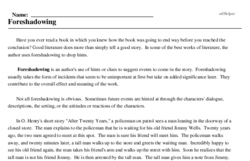Foreshadowing
Have you ever read a book in which you knew how the book was going to end way before you reached the conclusion? Good literature does more than simply tell a good story. In some of the best works of literature, the author uses foreshadowing to drop hints.
Foreshadowing is an author's use of hints or clues to suggest events to come in the story. Foreshadowing usually takes the form of incidents that seem to be unimportant at first but take on added significance later. They contribute to the overall effect and meaning of the work.
Not all foreshadowing is obvious. Sometimes future events are hinted at through the characters' dialogue, descriptions, the setting, or the attitudes or reactions of the characters.
In O. Henry's short story "After Twenty Years," a policeman on patrol sees a man leaning in the doorway of a closed store. The man explains to the policeman that he is waiting for his old friend Jimmy Wells. Twenty years ago, the two men agreed to meet at this spot. The man is sure his friend will meet him. The policeman walks away, and twenty minutes later, a tall man walks up to the store and greets the waiting man. Incredibly happy to see his old friend again, the man takes his friend's arm and walks up the street with him. Soon he realizes that the tall man is not his friend Jimmy. He is then arrested by the tall man. The tall man gives him a note from Jimmy. The note said that Jimmy had been at the appointment place on time but recognized his friend's face from a wanted poster from the Chicago police. Since Jimmy had not wanted to arrest his old friend, he found another policeman to do it for him.
Foreshadowing often serves two purposes. It builds suspense by raising questions that encourage the reader to go on and find out more about the event that is being foreshadowed. Foreshadowing is also a means of making a narrative more believable by partially preparing the reader for events that are to follow.




